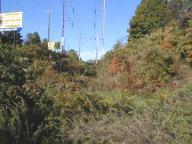Newtown Square Branch Trail: Marshall Road area
| < Previous | Up | Next > |
After the Cardington Branch splits off, the Newtown Square Branch curves to the northwest. The right-of-way crosses Marshall Road, but the bridge has been demolished.
Looking northwest. This is just southeast of Marshall Avenue; the former bridge was just ahead.
Looking back southeast.
A nice little secret passage from the right-of-way over to Coverly Road. There are many places like this where the multiuse trail can easily hook into the street system.
One of the many places where the wooden ties are still visible.
Another view of the lumberyard's encroachment onto the right-of-way. This is looking east from the beginning of East Marshall Rd.
| < Previous | Up | Next > |







